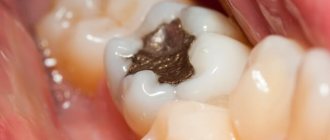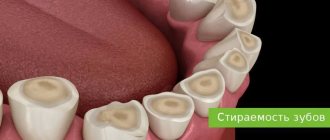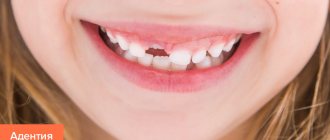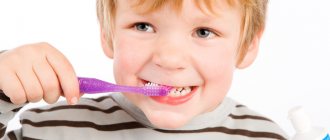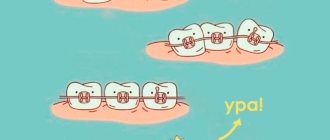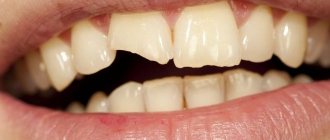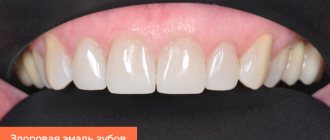The appearance of our front teeth plays a very important role in how others perceive our appearance. They are not only the first thing that catches your eye when you smile, but they are also more likely to be injured than others. You hear a lot from patients who have had a piece of their tooth chipped : “I couldn’t dodge a blow during training,” “I had nothing to open a bottle of beer with,” “I chewed on a caramel.” Enamel, which is the hardest tissue in the body, does not always withstand falls from a horse and hits from a tennis ball. As a result, chips of various sizes are formed on the cutting edge of the tooth. What can modern dentistry offer in this case?
Types of injuries to baby teeth
To choose a method to restore a broken baby tooth, you first need to determine the type of injury.
Chip on a baby tooth
A chip can occur from minor damage: a child grinds his teeth in his sleep (a common sign of helminth infection), ate solid food (crackers) or chewed a pencil, or bit a spoon unsuccessfully. When examining the oral cavity, it is discovered that a piece of the child’s baby tooth has broken off, the lower edge of the crown has become uneven and scratches the tongue. In this case, it is important to determine the extent of the damage.
If a red dot is visible on the surface of the chip, then the injury is serious and affects the pulp (nerve). And although the child will complain of acute pain when eating cold/hot food, the broken tooth can be saved.
Horizontal crack
A crack indicates an incomplete fracture of the tooth. The baby tooth has not cracked, but the crown is loose, and when the teeth are closed and biting, a sharp pain appears. The most difficult case is when the child fell, the tooth did not break off, but a crack appeared on the crown along the edge of the gum. In this case, you will likely need to strengthen the tooth with a thin veneer.
Baby tooth broken at the root
Did the kid bring a broken tooth in his hand? Unfortunately, with such an injury, it will not be possible to restore the integrity of the dentition. However, you still need to go to the dentist in order to remove the remaining fragments from the gums.
Impacted tooth fracture
With such an injury, the tooth is partially immersed in the gum. The length of the tooth is reduced compared to other crowns, but its edge is not sharp and does not scratch. Characterized by diffuse pain in the jaw. Sometimes the injury is accompanied by heavy bleeding due to the many small vessels in the gums of children.
Fractures of the alveolar process and jaw due to impacted tooth trauma are extremely rare, since the roots of baby teeth are quite short. Damage to bone tissue is indicated by severe pain spreading throughout the entire jaw on one side, the inability to open the mouth wide and a change in the bite.
Displacement of a baby tooth
With a strong blow, damage to the coronal part may be accompanied by complete or incomplete dislocation. A child’s tooth (often a front one) breaks off and takes an unusual position in the socket: it moves to the side, moves forward or backward, and turns around its axis. In this case, the tooth becomes loose, causing pain, and the child refuses to eat. The gums swell a little. In case of such an injury, the tooth is saved, but treatment may last several weeks.
Important! A chip in a baby tooth allows bacteria access to the dentin. Caries appears on the damaged crown. This often leads to its destruction within a couple of months and tooth loss.
Why is enamel damaged in children?
Tooth enamel in children can begin to deteriorate for dozens of reasons, the most common of which are:
- Metabolic disorders in the body, as a result of which the teeth do not receive proper nutrition;
- Disorders in the pretanal period, as well as at the age of six months to one and a half years, when all systems in the body are formed.
- Complications during pregnancy - Rh conflict between mother and fetus, severe toxicosis.
- Diseases suffered during pregnancy - rubella, toxoplasmosis, endocrine disorders, influenza, HIV, syphilis, taking hormonal or antibacterial drugs by the expectant mother.
- Chronic childhood diseases - infections, diseases of the digestive system, brain dysfunction, various types of dystrophy.
- Lack of fluoride and calcium in the body.
- Consuming large amounts of sweets, sodas, and sour foods.
- Lack of or negligent attitude towards personal hygiene, bad habits - biting nails, pencils and pens.
- Bruxism (constant rubbing of teeth against each other).
What to do if the enamel begins to peel off?
If you notice that the top layer of your child’s teeth has become thinner, or the baby begins to complain of increased sensitivity of the crowns, you should contact your dentist as soon as possible. The doctor will determine the degree of enamel destruction and prescribe appropriate treatment.
At the initial stage of damage to dental enamel in children, the doctor may prescribe remineralization of the enamel - its saturation with minerals, calcium and fluoride. Using this method, you can strengthen your baby’s teeth in 5-20 days.
If noticeable stains appear on the baby’s tooth enamel, the dentist can perform a filling using special composite materials or install veneers and lumineers to hide the problem.
Prevention of enamel damage
As you know, the best treatment is prevention. To ensure that your child does not suffer from damaged enamel and all the symptoms arising from the pathology, from his very tender age it is worth thinking about strengthening the enamel.
- Balance your diet.
The child must receive all the necessary vitamins and microelements. When breastfeeding, it is also important to plan the nursing mother's menu. The healthiest foods for teeth are dairy and fermented milk dishes, as well as fruits and vegetables. - Treat all diseases on time.
Remember, everything in a child’s body is interconnected, so all acute and chronic diseases must be eliminated in a timely manner. - Teach your child to take care of himself.
Good oral hygiene will help prevent dental problems. Teach your child to brush their teeth twice a day, floss, and rinse their mouth after meals. An excellent means of protection for fragile children's enamel is ASEPTA TEENS toothpaste, created to protect and strengthen the enamel of permanent teeth. The active formula with amino fluoride forms a coating on the enamel of children's teeth, which protects against the negative effects of bacteria and acids and prevents the destruction of enamel. - Keep an eye on your child.
Don't forget, one of the key reasons for the destruction and thinning of children's enamel is mechanical trauma. Keep an eye on your beloved baby and you will minimize the risk of damage.
What to do if a child's baby tooth breaks off
- Is the child scared and crying? Try to calm him down. Take it in your arms, turn on your favorite cartoon or distract your baby with a game.
- If there is bleeding, apply a sterile gauze pad (do not use cotton wool - the fibers may stick to the chip).
- Try to find the tooth fragment as quickly as possible. Place it in saline solution, boiled water or wrap it in a damp cloth. This will make it easier to restore a child’s broken baby tooth.
- For pain, you can give Nurofen or paracetamol.
- If a fracture is suspected, make a circular bandage around the head, securing the lower jaw.
It is necessary to get an appointment with a dentist within the first 2-48 hours. Don't forget to take the saved tooth fragment with you.
How are chips fixed?
It’s clear that you won’t be able to fix this on your own, so contact a specialist. The doctor will protect the tooth from further destruction. Depending on where the chip is located and the degree of destruction, various treatment methods are used.
- Seal. If the chip is small, then this option will correct the damage and restore aesthetics and chewing function.
- Veneers. This method is well suited for cases where it is not possible to grow a tooth. Moreover, they will retain an attractive appearance for a long time without losing strength.
- Tabs. Used for chewing teeth. This method returns the anatomical shape, while they do not wear off or shrink.
- Crown. If a significant part of the tooth has been damaged, then after removing the nerve and treating the canals, a crown is installed. The material is selected depending on which tooth is damaged.
Possible treatment options
The method of preserving a damaged baby tooth depends on the degree of damage. Sometimes the dentist suggests taking an x-ray to diagnose damage to adjacent crowns, tooth dislocation and assess the condition of surrounding tissues. Before restoring a tooth, the dentist performs hygienic treatment of the oral cavity.
Treatment methods for a chipped baby tooth
- Enamel chipped - polishing the sharp edges of the crown.
- A baby tooth has broken off within the dentin - building it up with photocomposite material or covering the chip with a crown fragment.
- Fracture exposing the dental nerve - reconstruction using a tooth fragment.
- Mobility, displacement of teeth - applying a splint to the damaged tooth and two adjacent crowns (one on the right and on the left) under local anesthesia.
- A child has a cracked baby tooth in the root zone - sealing the damage and strengthening the crown with an onlay.
Thanks to the precise selection of the color of the composite material, the restored baby tooth does not differ from healthy crowns. The child will not experience psychological discomfort, but the teeth must be treated with care to avoid repeated chipping.
Three artistic restoration options
A partially destroyed front tooth is restored using direct and indirect methods: modeling it using modern composite materials and installing onlays and veneers.
- Minor damage can be repaired with composite fillings .
- In more serious cases, when dentin chips, not only a photocomposite, but also a pin or a special inlay are used to build up the crown. Working in pairs, they will restore functionality to the tooth, and it will not even need to be covered with an artificial crown.
- By installing veneers as an alternative to fillings on the front teeth , dentists do an excellent job with external chips. It is much easier to work with ceramic plates, primarily because of the ability to quickly and easily achieve complete similarity of the imitation with neighboring natural teeth.
Prevention of injuries to baby teeth
- If possible, stop the child’s attempts to try everything by heart.
- Teaching your child how to properly brush their teeth.
- Children's toothbrush with soft bristles.
- A nutritious diet with sufficient calcium and fluoride.
- Regularly remind your child about the dangers of chewing pens and pencils.
- Carry out deworming periodically, especially if there are pets in the house.
- Visit your dentist in a timely manner to correct your bite.
- Treat initial caries (at the spot stage) immediately.
- Have a dental examination every year.
If a child has a broken baby tooth, the dentists at the First Family Clinic of St. Petersburg will carefully examine and, if possible, restore the damaged crown. We guarantee excellent aesthetic results. Your child will quickly forget about the injury.
What will happen if left untreated?
Of course, the complexity and speed of events depends on how large a part of the tooth has broken off. It all starts with increasing the sensitivity of the affected tooth. If the chip is not treated, the destruction becomes deeper, and as the nerve is exposed, the pain increases. Inflammation may begin, which will subsequently lead to inflammation of the pulp and removal of the nerve. If you do not seek professional help, further symptoms will only worsen and become more severe.
Therefore, if even a small piece within the enamel breaks off, do not wait until problems begin, make an appointment with the dentist and resolve the issue in a timely manner.
Come to Dr. Konnov's dentistry, we will restore your smile to health and attractiveness!
Chipped tooth: emergency help
If a piece of a tooth breaks off, before visiting the dentist you should take care of the following first aid:
- Rinse your mouth with clean water;
- Treat the oral cavity with an antiseptic solution;
- To prevent inflammation, we recommend applying a cold compress to the damaged area;
- If you feel severe pain, you can take local analgesics.
Such measures can prevent various undesirable consequences, including infection and inflammatory processes.
Types of damage to dental tissues
Experts classify damage to dental tissues according to the degree of damage and depth of injury.
Enamel chip
Enamel chips or microcracks almost never cause discomfort. Unfortunately, many patients consider this problem not serious enough and are in no hurry to seek help from specialists, except in cases where a front tooth has chipped off. This is wrong behavior. The thing is that in places of chips and microcracks, pathogenic microflora instantly develops, contributing to the development of caries and other dental problems.
Even with the most minor changes in the integrity of the tooth, we recommend seeking professional help as soon as possible. Such defects are eliminated quickly and painlessly.
Dentin damage
Dentin is the dense tissue underneath the enamel. When damage affects this layer, patients most often experience pain when drinking hot and cold drinks. If a piece of a tooth breaks off, you should contact the dentist as soon as possible. Otherwise, the tooth will gradually crumble.
Damage to pulp tissue
This injury is of high severity and is accompanied by severe pain and bleeding. In this case, the patient requires emergency assistance from a specialist. If the necessary measures are not taken in time, the risk of inflammation or infection increases.
Causes of dental injury
In fact, one of the important factors affecting the strength of teeth is the amount of calcium in the body. The lack of this element leads to a weakening of tooth enamel, which protects other tissues from damage and irritating factors. Damaged tooth enamel is unable to cope with serious mechanical stress, so a tooth can break off even when biting an apple. But the damage may not be associated with weakening of protective tissues. The most common causes of chipping are:
- Various injuries;
- Dental pathologies;
- Various disorders in the hormonal system;
- Nocturnal bruxism;
- Carious lesions in advanced stages;
- Incorrect placement of incisors or canines;
- Decreased immunity;
- An unbalanced diet leading to disruption of the acid-base balance in the oral cavity;
